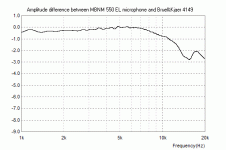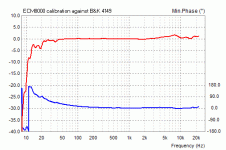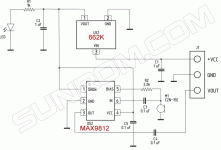OK, great thread!
While I do not understand english not yet very well, I have very trivial question. Just starting to build up my spekaer measurement system: using ARTA software (manual 180 pages HUH ), I do have EMC8000 (not calibrated) and looking the last component? (good soundcard, preamp). So I found EMU Tracker Pre could be handy. Do I need preamp for EMC8000 (EMU does have it build in)?
), I do have EMC8000 (not calibrated) and looking the last component? (good soundcard, preamp). So I found EMU Tracker Pre could be handy. Do I need preamp for EMC8000 (EMU does have it build in)?
While I do not understand english not yet very well, I have very trivial question. Just starting to build up my spekaer measurement system: using ARTA software (manual 180 pages HUH
There has been some talk about soundcards usefullness or not. I have a MOTU UltraLight Mk. III with no technical data at all about the mic preamps. If I manage to locate some data, what in particular am I looking for, and any mini- or max values to look out for?
I am planning to use the Panasonic WM61 if I can find any, and build myself a calibrated mic (calibration file) and hopefully use it directly with my soundcard.
I am planning to use the Panasonic WM61 if I can find any, and build myself a calibrated mic (calibration file) and hopefully use it directly with my soundcard.
I'm thinking of giving the DIY Panasonic mic capsule a try. However, I'm wondering about the complexity and difficulty for a complete newbie to take on such a project.
As I understand it, you need an output transformer for the capsule, and then a soundcard with phantom power?
If I give it a try, the modification feels like a must. I think I've seen two or three different versions of the mod.
As I understand it, you need an output transformer for the capsule, and then a soundcard with phantom power?
If I give it a try, the modification feels like a must. I think I've seen two or three different versions of the mod.
I build myself a cheap measurement mic for soundcards some time ago:
http://www.diyaudio.com/forums/multi-way/99324-monacor-mce-4000-a.html
regards
http://www.diyaudio.com/forums/multi-way/99324-monacor-mce-4000-a.html
regards
For those wishing to use the Panasonic WM-61A, here is a link for a Walin Preamp for it.
http://www.madaboutsound.com/prod_det.asp?cid=112&sa=cf&ctid=4
Plus a calibration file.
Mods to the WM-61A itself are at Linkwitz lab site.

http://www.madaboutsound.com/prod_det.asp?cid=112&sa=cf&ctid=4
Plus a calibration file.
Mods to the WM-61A itself are at Linkwitz lab site.
For those wishing to use the Panasonic WM-61A, here is a link for a Walin Preamp for it.
Mad About Sound | Microphone Preamplifier PCB v1.1
Plus a calibration file.
Mods to the WM-61A itself are at Linkwitz lab site.

The kit is no longer available, only the PCB. Would it be considered as a good preamp? A ready made PCB is definitely a huge plus for me.
I made the simple panasonic wm-61 based amp listed here -
<B>How to Build a Condensor Microphone... a Do it Yourself project.</B>
It works with my computers onboard sound without any other hardware. I put an on/off switch in it to take it easy on the battery, as I use it infrequently.
<B>How to Build a Condensor Microphone... a Do it Yourself project.</B>
It works with my computers onboard sound without any other hardware. I put an on/off switch in it to take it easy on the battery, as I use it infrequently.
Last edited:
The kit is no longer available, only the PCB. Would it be considered as a good preamp? A ready made PCB is definitely a huge plus for me.
Here is the source of circuit, widely used !
Eric Wallin's Internet Homepage
the PCB is not expensive, have a go !!!
Hello. I have read the importance of using a calibrated measurement microphone. However, i don't want to spend my money on one yet because I have a studio microphone, the SE 2200T.
Amazon.com: SE Electronics SE2200T Condenser Studio Microphone: Musical Instruments
"The SE2200T has a sensitivity of ‑33dB (+1dB) where 0dB=1v/Pa at 1kHz, and it is pretty quiet for a tube mic. Its equivalent input noise level (EIN) is specified as 16dB A‑weighted, making it one dB quieter than the solid‑sate version, which is unusual (tube mics tend to be noisier than FET mics, all else being equal). The maximum SPL measured at 0.5 percent THD at 1kHz is 130dB without the pad switched in, which, again, is some 5dB higher than for the SE2200A, and is presumably due to the greater headroom of the tube circuitry."
Quote from Sound on sound magazine.
So, I was wondering if this microphone, with my TC Electronic Impact Twin soundcard can be used as a measuring microphone. If so, how can I calibrate it? I also have a pair of Samson Rubicon R6a monitors.
Amazon.com: SE Electronics SE2200T Condenser Studio Microphone: Musical Instruments
"The SE2200T has a sensitivity of ‑33dB (+1dB) where 0dB=1v/Pa at 1kHz, and it is pretty quiet for a tube mic. Its equivalent input noise level (EIN) is specified as 16dB A‑weighted, making it one dB quieter than the solid‑sate version, which is unusual (tube mics tend to be noisier than FET mics, all else being equal). The maximum SPL measured at 0.5 percent THD at 1kHz is 130dB without the pad switched in, which, again, is some 5dB higher than for the SE2200A, and is presumably due to the greater headroom of the tube circuitry."
Quote from Sound on sound magazine.
So, I was wondering if this microphone, with my TC Electronic Impact Twin soundcard can be used as a measuring microphone. If so, how can I calibrate it? I also have a pair of Samson Rubicon R6a monitors.
..If so, how can I calibrate it?
You can send it off to a lab for calibration, but that will likely cost more than a cheap calibrated mic:
Dayton Audio EMM-6 Electret Measurement Microphone
..still too much money?
Dayton Audio iMM-6 Calibrated Measurement Microphone for iPhone iPad Tablet and Android
Note that non-linear distortion measurements are compensated for by the program.. so even if the mic has less than good harmonic distortion figures that it won't matter for most tests.
Freq. response measurements just need calibrated linearity (..which the two above will have when you download the compensation curve for the mic you purchase and implement it in your measurement program).
And how you're going to perform synchronous AD/DA measurements (check the ARTA manual) or dual channel measurements with your USB mike?
This is true, but most measurements won't require this.. kind of a bummer to miss-out on acoustic phase though.
Still, perhaps the best reason for NOT purchasing a USB mic in this instance is that misuspita already has the TC Electronic Impact Twin soundcard - which doesn't have the limitations that his mic has (versus cheap calibrated mic's).
Yes, the SE 2200T is a really nice mic, actually a extremely good mic, didnt expected it when I bought it, most of my friends come to me for voice and acoustic guitar recording, it's that good. It actually has a smallish (1dB I guess) 6kHz gentle swell, which has, besides the tube, a good effect on voices. But besides that it is flat. Thats why I thought I can use it as a measuring device... Because I trust it and have a 4 years experience with it and I know what it sounds like. But that is subjective, not objective quantification 
I agree with ScootG they say :
Dayton Audio EMM-6 Electret Measurement Microphone
Dayton Audio iMM-6 Calibrated Measurement Microphone for iPhone iPad Tablet and Android
But I have in my drawer the Mic with amplifier :
MAX9812 Microphone Amplifier Sound MIC Voice Module for Arduino 3.3V/3.5V for raspberry pi 1 2 3 b w MAX9812 Microphone Amplifier Sound MIC Voice Module for Arduino 3.3V/3.5V for raspberry pi 1 2 3 b od Microphones na Aliexpress.com | Grupa Alibaba
For , used for Arduino. It is possible to find a producer of this module :
Microphone Amplifier MAX9812 [4836] : Sunrom Electronics/Technologies
Schematic - MAX9812-schematic.gif
Mic capsule - CZN-15E
Mic amplifier MAX9812
Power supply XC6206
Could anyone try to compare but calibrate with calibration mic.
Dayton Audio EMM-6 Electret Measurement Microphone
Dayton Audio iMM-6 Calibrated Measurement Microphone for iPhone iPad Tablet and Android
But I have in my drawer the Mic with amplifier :
MAX9812 Microphone Amplifier Sound MIC Voice Module for Arduino 3.3V/3.5V for raspberry pi 1 2 3 b w MAX9812 Microphone Amplifier Sound MIC Voice Module for Arduino 3.3V/3.5V for raspberry pi 1 2 3 b od Microphones na Aliexpress.com | Grupa Alibaba
For , used for Arduino. It is possible to find a producer of this module :
Microphone Amplifier MAX9812 [4836] : Sunrom Electronics/Technologies
Schematic - MAX9812-schematic.gif
Mic capsule - CZN-15E
Mic amplifier MAX9812
Power supply XC6206
Could anyone try to compare but calibrate with calibration mic.
Attachments
- Status
- This old topic is closed. If you want to reopen this topic, contact a moderator using the "Report Post" button.
- Home
- Loudspeakers
- Multi-Way
- DIY measurement mic


